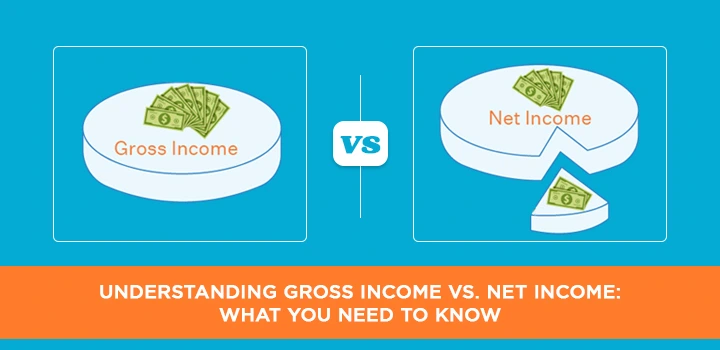-
Posted on: 07 Aug 2023

-
Understanding the difference between gross income and net income is fundamental for personal finance and business success. This guide breaks down these crucial financial concepts, helping you grasp what each figure represents and how it impacts your financial health and decision-making. Get ready to demystify your earnings.
What is Gross Income?
Gross income is the total amount of money earned before any deductions are taken out. It represents the "top-line" figure of your earnings. For individuals, this typically includes salary, wages, tips, bonuses, and any other forms of compensation received from employment. For businesses, gross income, often referred to as gross profit, is the revenue generated from sales minus the cost of goods sold (COGS). It's a foundational metric that shows the raw earning potential before accounting for operational expenses, taxes, or other liabilities.
Think of it as the total pie before anyone slices it. This initial amount is crucial for understanding the full scope of your earning capacity or a business's sales performance. However, it's not the amount you actually get to keep or reinvest, as significant portions will be allocated to various expenses and obligations. In 2025, understanding this starting point is more critical than ever as economic conditions continue to evolve, impacting both individual earning power and business profitability.
Sources of Gross Income for Individuals
For individuals, gross income is a broad category encompassing all forms of earnings before taxes and other deductions. This includes:
- Wages and Salaries: The regular pay received from an employer for services rendered. This is often the largest component of an individual's gross income. In 2025, the average annual salary in the United States is projected to be around $60,000, but this varies significantly by industry and location.
- Tips: Income earned by service workers, which can be a substantial part of their total earnings. Many service industry jobs rely heavily on tips, making this a critical component of their gross income.
- Bonuses and Commissions: Additional compensation often paid for exceeding performance targets or as a reward for exceptional work. These can be one-time payments or recurring incentives.
- Self-Employment Income: Earnings from freelance work, independent contracting, or running a small business. This is the gross revenue generated from services or products sold, before deducting business expenses.
- Investment Income: Earnings from investments such as dividends from stocks, interest from bonds or savings accounts, and capital gains from selling assets. For example, in early 2025, dividend yields for major indices are hovering around 1.5-2.0%.
- Rental Income: Income generated from properties owned and leased out to tenants. This is the total rent collected before deducting property taxes, mortgage interest, and maintenance costs.
- Alimony Received: Payments received from a former spouse as part of a divorce settlement.
- Retirement Distributions: Withdrawals from retirement accounts like 401(k)s or IRAs, although these are often taxed differently and may be considered taxable income depending on the account type and age.
It's important to note that the definition of gross income can vary slightly depending on the context, such as for tax purposes versus for loan applications. However, the core principle remains the same: it's the total earnings before any subtractions.
Gross Profit for Businesses
For businesses, gross income is synonymous with gross profit. This is a key indicator of a company's operational efficiency and its ability to generate revenue from its core products or services. The calculation is straightforward:
Gross Profit = Total Revenue - Cost of Goods Sold (COGS)
Total Revenue refers to the total sales generated from selling products or services. Cost of Goods Sold (COGS) includes all direct costs associated with producing or acquiring the goods sold by a company. This can include raw materials, direct labor, and manufacturing overhead directly attributable to production.
For instance, if a retail store generates $100,000 in sales in a month and the cost of the inventory they sold was $40,000, their gross profit for that month would be $60,000. This $60,000 is then available to cover operating expenses, interest, taxes, and ultimately, net profit.
What is Net Income?
Net income, often called the "bottom line," is the amount of money remaining after all expenses, taxes, and deductions have been subtracted from gross income. It represents the actual profit or earnings that an individual or business has available to spend, save, reinvest, or distribute. For individuals, this is the amount that appears in your bank account after payroll deductions. For businesses, it's the profit that can be retained by the company or paid out to shareholders.
Net income provides a more realistic picture of financial health than gross income because it accounts for all the costs associated with generating that income. In 2025, with rising costs of living and business operations, understanding your net income is crucial for budgeting, financial planning, and assessing true profitability. It's the figure that truly matters for making financial decisions.
Deductions from Gross Income for Individuals
For individuals, gross income is reduced by various deductions to arrive at net income. These deductions can be categorized into several types:
- Taxes: This is typically the largest deduction. It includes federal, state, and local income taxes, as well as FICA taxes (Social Security and Medicare). The exact tax amount depends on income level, filing status, deductions, and credits. For 2025, federal income tax brackets remain progressive, with top rates potentially reaching 37%.
- Health Insurance Premiums: The portion of health insurance costs paid by the employee.
- Retirement Contributions: Contributions made to employer-sponsored retirement plans like 401(k)s or 403(b)s. These contributions are often pre-tax, reducing taxable income. For 2025, the maximum employee contribution to a 401(k) is expected to be around $23,000.
- Other Benefits: Premiums for life insurance, disability insurance, or other voluntary deductions elected by the employee.
- Wage Garnishments: Court-ordered deductions from wages, such as for child support or defaulted loans.
The net income, also known as take-home pay, is the amount an individual has available for personal expenses, savings, and investments after all these deductions are made.
Net Profit for Businesses
For businesses, net income, or net profit, is calculated after deducting all operating expenses, interest, and taxes from the gross profit. The formula is:
Net Income = Gross Profit - Operating Expenses - Interest - Taxes
Operating Expenses include costs like rent, utilities, salaries of non-production staff, marketing, administrative costs, and depreciation. Interest refers to the cost of borrowing money. Taxes are corporate income taxes levied by governments.
A business with a gross profit of $60,000 might have operating expenses of $30,000, interest payments of $5,000, and taxes of $10,000. In this scenario, the net income would be $60,000 - $30,000 - $5,000 - $10,000 = $15,000. This $15,000 is the true profit the business has earned.
Key Differences and Comparison
The fundamental distinction between gross income and net income lies in what is included in the calculation. Gross income is the total revenue before any deductions, while net income is the final amount remaining after all deductions. Understanding this difference is vital for accurate financial assessment.
Feature Gross Income Net Income Definition Total earnings before deductions. Earnings remaining after all deductions. Calculation Basis Revenue (business) or total compensation (individual). Gross Income minus all expenses, taxes, and liabilities. Represents Earning potential or total sales. Actual profit or take-home pay. Key Components Sales, wages, salaries, bonuses, interest, dividends. Operating expenses, COGS (for gross profit calculation), interest, taxes, insurance, retirement contributions. Usefulness Assessing top-line performance, potential borrowing capacity. Assessing true profitability, personal financial health, budgeting, investment decisions. For Individuals Pre-tax salary/wages. Take-home pay. For Businesses Gross Profit (Revenue - COGS). Net Profit (Bottom Line). In essence, gross income tells you how much money is coming in initially, while net income tells you how much money you actually have available to use. For individuals, a higher gross income doesn't necessarily mean more disposable income if deductions are substantial. Similarly, a business with high gross profit might struggle if its operating expenses are excessive.
Illustrative Example: Individual Earnings
Let's consider an individual, Sarah, who works as a marketing manager. In 2025, her annual salary is $80,000.
- Gross Income: Sarah's gross annual income is $80,000. Her gross monthly income is approximately $6,667 ($80,000 / 12).
- Deductions:
- Federal Income Tax (estimated): $10,000 annually
- State Income Tax (estimated): $4,000 annually
- FICA Taxes (Social Security & Medicare): $6,120 annually (7.65% of gross)
- Health Insurance Premium (employee portion): $2,400 annually
- 401(k) Contribution (pre-tax): $5,000 annually
- Total Deductions: $10,000 + $4,000 + $6,120 + $2,400 + $5,000 = $27,520 annually.
- Net Income: $80,000 (Gross Income) - $27,520 (Total Deductions) = $52,480 annually.
Sarah's net monthly income is approximately $4,373 ($52,480 / 12). This $4,373 is the amount she has available for rent, food, utilities, savings, entertainment, and other personal expenses. The difference between her gross and net income highlights the significant impact of taxes and benefits on her available funds.
Illustrative Example: Business Operations
Consider a small bakery, "Sweet Delights," that sells cakes and pastries. In a given month in 2025:
- Total Revenue: $50,000 (from sales of cakes, pastries, etc.)
- Cost of Goods Sold (COGS): $20,000 (cost of ingredients like flour, sugar, butter; direct labor for bakers)
- Gross Profit: $50,000 - $20,000 = $30,000
- Operating Expenses:
- Rent: $4,000
- Utilities: $1,000
- Salaries (non-baker staff): $6,000
- Marketing: $500
- Supplies (cleaning, packaging): $1,000
- Depreciation on ovens: $500
- Interest Expense: $500 (on a business loan)
- Taxes (estimated): $4,000
- Net Income: $30,000 (Gross Profit) - $13,000 (Operating Expenses) - $500 (Interest) - $4,000 (Taxes) = $12,500
Sweet Delights' gross profit is $30,000, indicating it's making a healthy margin on its products. However, its net income is $12,500, which is the actual profit available for reinvestment, owner's draw, or to build cash reserves. This shows that while sales are strong, managing operating costs is crucial for profitability.
Calculating Gross Income
The calculation of gross income is straightforward, but its components differ for individuals and businesses. The key is to identify all sources of revenue or compensation before any deductions are applied.
Step-by-Step for Individuals
To calculate your gross income, you need to sum up all the money you've earned from various sources within a specific period (e.g., a month or a year). Here's how:
- Identify all income sources: List every way you received money. This includes your regular salary or wages, any overtime pay, tips, bonuses, commissions, income from side hustles, rental income, dividends, interest, etc.
- Gather documentation: Collect pay stubs, bank statements, tax forms (like W-2s, 1099s), and any other records that show your earnings.
- Sum up the earnings: Add together the amounts from all identified income sources for the period you are analyzing. Ensure you are using the amounts before any taxes or deductions are taken out. For example, if your pay stub shows a gross pay of $3,000, use that $3,000, not the net pay.
- Consider tax-exempt income (if applicable): Some income, like certain fringe benefits or contributions to specific retirement accounts, might be excluded from taxable income but are still considered part of your overall gross income for certain purposes. However, for a basic understanding of your "earned" gross income, focus on direct compensation.
Example: If an individual earned $4,000 in salary, $500 in freelance work, and $100 in interest from a savings account in a month, their gross income for that month would be $4,000 + $500 + $100 = $4,600.
Step-by-Step for Businesses
For businesses, calculating gross income (gross profit) is a critical step in understanding the profitability of their core operations.
- Determine Total Revenue: This is the total amount of money generated from the sale of goods or services during a specific accounting period. It's the "top line" of your income statement.
- Calculate Cost of Goods Sold (COGS): This includes all direct costs incurred to produce or acquire the goods that were sold. For a manufacturing company, this might include raw materials, direct labor, and factory overhead. For a retailer, it's primarily the purchase cost of inventory.
- Inventory Valuation: COGS calculation often involves inventory valuation methods like FIFO (First-In, First-Out) or LIFO (Last-In, First-Out), which can impact the COGS figure.
- Formula for COGS: Beginning Inventory + Purchases - Ending Inventory = COGS.
- Subtract COGS from Total Revenue: The result is your gross profit.
Gross Profit = Total Revenue - COGS
Example: A software company sells subscriptions. In Q1 2025, they generated $200,000 in subscription revenue. The direct costs associated with delivering this service (e.g., server costs, direct customer support for the service) amounted to $50,000. Their gross profit for Q1 2025 is $200,000 - $50,000 = $150,000.
Calculating Net Income
Calculating net income involves a more comprehensive subtraction of all costs and liabilities from the gross income figure. This process reveals the true profitability or available funds.
Step-by-Step for Individuals
To calculate your net income (take-home pay), you start with your gross income and subtract all applicable deductions.
- Start with Gross Income: Use the total gross income figure you calculated previously.
- Identify and Sum All Deductions: This includes mandatory deductions like federal, state, and local income taxes, Social Security, and Medicare (FICA). It also includes voluntary deductions such as health insurance premiums, retirement plan contributions (e.g., 401(k), IRA), union dues, and any wage garnishments.
- Subtract Total Deductions from Gross Income: The remaining amount is your net income.
Net Income = Gross Income - Total Deductions
- Consider Taxable vs. Non-Taxable Income: For tax purposes, some income might be tax-exempt, but for calculating your net pay from an employer, you typically start with your gross pay before any pre-tax deductions are applied. The net income is what you receive in your bank account.
Example: Using Sarah's previous example, her gross income was $80,000. Her total deductions were $27,520. Her net income is $80,000 - $27,520 = $52,480 annually, or approximately $4,373 monthly. This is the amount she can budget for her living expenses.
Step-by-Step for Businesses
Calculating net income for a business requires deducting all expenses from gross profit. This is typically done on an income statement.
- Start with Gross Profit: Use the gross profit figure calculated previously (Total Revenue - COGS).
- Identify and Sum Operating Expenses: These are the costs of running the business that are not directly tied to production. Common operating expenses include rent, utilities, salaries (for administrative, sales, and marketing staff), marketing and advertising costs, office supplies, insurance, repairs, and depreciation.
- Subtract Interest Expense: This is the cost of borrowing money, such as interest paid on loans or bonds.
- Subtract Taxes: This includes federal, state, and local income taxes that the business owes.
- Calculate Net Income: Subtract the sum of operating expenses, interest, and taxes from the gross profit.
Net Income = Gross Profit - Operating Expenses - Interest Expense - Taxes
- Alternative Calculation: Some businesses may also account for other income or expenses not related to core operations, such as gains or losses from asset sales, which would be factored in before arriving at the final net income.
Example: For Sweet Delights bakery, the gross profit was $30,000. Total operating expenses were $13,000, interest was $500, and taxes were $4,000. Their net income is $30,000 - $13,000 - $500 - $4,000 = $12,500. This is the "bottom line" profit.
Gross Income vs. Net Income for Individuals
For individuals, the distinction between gross income and net income is crucial for personal financial management. It dictates how much money is actually available for daily living, savings, and discretionary spending.
Gross Income: The Starting Point
Your gross income is the headline figure. It's what employers often advertise as salary ranges and what lenders might look at to assess your earning capacity for loans like mortgages. For example, if a job posting states a salary of $70,000, that's the gross annual income. This figure doesn't reflect the actual amount that will hit your bank account each pay period. In 2025, understanding your gross income is the first step in budgeting and financial planning, providing a benchmark for your earning power.
Net Income: The Reality of Your Spending Power
Net income, or take-home pay, is the money you have left after all deductions. This is the amount you can realistically budget for rent or mortgage payments, groceries, utilities, transportation, entertainment, and savings. If your gross income is $70,000 annually, but after taxes, health insurance, and retirement contributions, your net income is $50,000, then $50,000 is your true spending and saving power. This is why focusing solely on gross income can be misleading when assessing your financial well-being.
Impact of Deductions
The difference between gross and net income can be significant. In 2025, with evolving tax laws and rising healthcare costs, these deductions can amount to 20-30% or even more of an individual's gross income. For instance, a person earning $100,000 gross might only take home $70,000-$75,000 net, depending on their state and benefit elections.
- Taxes: Federal, state, and local income taxes are often the largest chunk.
- FICA: Social Security (6.2% up to a certain limit) and Medicare (1.45%) taxes are mandatory.
- Benefits: Health, dental, vision insurance premiums, life insurance, disability insurance.
- Retirement Contributions: Pre-tax contributions to 401(k)s, 403(b)s, or other retirement accounts reduce taxable income and thus your net income temporarily, but they are investments in your future.
Understanding these deductions helps individuals manage their finances more effectively. For example, knowing that a portion of your paycheck goes to retirement savings can provide peace of mind about your long-term financial security.
Why Net Income is Key for Personal Finance
Net income is the most relevant figure for day-to-day financial decisions:
- Budgeting: You can only spend what you have, so your budget must be based on your net income.
- Saving: The amount you can save for emergencies, down payments, or retirement is directly tied to your net income.
- Debt Management: Lenders assess your ability to repay debt based on your net income and existing obligations.
- Financial Goals: Achieving goals like buying a home or retiring comfortably depends on consistently saving and investing from your net income.
While gross income is important for understanding your overall earning potential, net income is the practical measure of your financial resources.
Gross Income vs. Net Income for Businesses
For businesses, the distinction between gross income (gross profit) and net income (net profit) is fundamental to understanding operational efficiency and overall financial health. It guides strategic decisions, investment, and profitability analysis.
Gross Profit: The Profitability of Core Operations
Gross profit indicates how effectively a business is managing its direct costs associated with producing or acquiring goods and services. A healthy gross profit margin suggests that the business can cover its production costs and still have a significant amount left to cover operating expenses, interest, and taxes.
- Industry Benchmarks: Businesses often compare their gross profit margins to industry averages. For example, in 2025, a typical retail business might aim for a gross profit margin of 40-50%, while a software company might target 70-80% or higher.
- Pricing Strategy: Gross profit is influenced by pricing and COGS. If COGS increases (e.g., due to rising material costs), the gross profit margin will shrink unless prices are adjusted.
- Operational Efficiency: Streamlining production processes, negotiating better supplier contracts, and minimizing waste can all improve gross profit.
Net Profit: The True Bottom Line
Net profit is the ultimate measure of a business's profitability. It shows how much money is left after all expenses, including those not directly related to production, have been paid. A positive net profit means the business is financially sustainable and can grow.
- Strategic Decision-Making: Net profit informs decisions about expansion, investment in new products, or potential acquisitions. A consistently low or negative net profit signals a need for significant strategic changes.
- Investor Confidence: Investors and lenders scrutinize net profit to gauge a company's performance and its ability to generate returns.
- Owner's Compensation: For small businesses, net profit often dictates the amount available for owner draws or dividends.
The Role of Operating Expenses and Other Costs
The difference between gross profit and net profit is made up of operating expenses, interest, and taxes. These are critical areas for cost management:
- Operating Expenses: These include salaries for administrative and sales staff, rent, marketing, utilities, etc. High operating expenses can erode even a strong gross profit. In 2025, businesses are particularly focused on optimizing these costs amidst inflation.
- Interest Expense: The cost of debt financing can significantly impact net profit, especially for companies with substantial loans.
- Taxes: Corporate tax rates can vary, and tax planning is essential to minimize this expense legally.
Example Scenario: A Manufacturing Company
Consider "TechGadgets Inc." in 2025:
- Revenue: $1,000,000
- COGS: $400,000
- Gross Profit: $600,000 (60% Gross Profit Margin)
- Operating Expenses:
- Salaries (non-production): $200,000
- Rent & Utilities: $50,000
- Marketing: $30,000
- Other Admin Costs: $20,000
- Interest Expense: $20,000
- Taxes: $100,000
- Net Profit: $600,000 - $300,000 - $20,000 - $100,000 = $180,000 (18% Net Profit Margin)
This example shows that while TechGadgets Inc. has a strong gross profit, its net profit is significantly lower due to substantial operating expenses, interest, and taxes. Managing these downstream costs is as crucial as generating revenue.
Why Understanding the Difference Matters
The distinction between gross and net income is not just an accounting technicality; it has profound implications for financial decision-making, planning, and overall financial health for both individuals and businesses.
For Individuals: Informed Financial Decisions
Understanding your net income is paramount for practical personal finance:
- Accurate Budgeting: You can only spend what you actually receive. Basing your budget on gross income will lead to overspending and financial strain.
- Realistic Savings Goals: Whether saving for a down payment, retirement, or an emergency fund, your savings capacity is determined by your net income.
- Debt Management: Lenders assess your ability to repay loans based on your disposable income (net income), not your total earnings.
- Investment Planning: Knowing your net income allows you to allocate funds effectively towards investments that will help you achieve long-term financial security.
- Tax Planning: Understanding gross income and the deductions that reduce it to net income is crucial for optimizing tax strategies and maximizing your take-home pay.
For Businesses: Sustainable Growth and Profitability
For businesses, the difference is critical for survival and growth:
- Operational Assessment: Gross profit reveals the efficiency of core operations. A declining gross profit margin signals issues with pricing, COGS, or production.
- Strategic Planning: Net profit is the ultimate indicator of a business's success. It dictates the ability to reinvest, expand, pay dividends, or weather economic downturns.
- Investor Relations: Investors rely on net profit figures to assess a company's performance and potential return on investment.
- Cost Management: The gap between gross and net profit highlights the impact of operating expenses, interest, and taxes, prompting businesses to seek efficiencies in these areas.
- Valuation: A company's market valuation is heavily influenced by its net profit and its growth trajectory.
Avoiding Misleading Figures
Focusing solely on gross income can create a false sense of financial security or success. For example:
- An individual might feel wealthy based on a high gross salary but struggle with monthly bills if their net income is significantly lower due to high taxes and living expenses.
- A business might report impressive revenue figures (related to gross income) but be on the verge of bankruptcy if its expenses are too high, leading to a negative net profit.
In 2025, with economic uncertainties and evolving market conditions, a clear understanding of both gross and net figures is more important than ever for making sound financial decisions and ensuring long-term stability.
Strategies to Increase Net Income
Whether you're an individual or a business owner, there are strategic approaches to boost your net income. This involves either increasing your gross income or reducing your expenses and taxes.
For Individuals:
Increasing your net income as an individual typically involves a combination of earning more and managing expenses wisely.
- Increase Gross Income:
- Seek a Raise or Promotion: Negotiate for higher pay at your current job based on performance and market value.
- Take on a Side Hustle: Freelancing, consulting, or starting a small online business can provide additional income streams.
- Develop New Skills: Acquire skills that are in demand to qualify for higher-paying roles.
- Optimize Investments: Ensure your savings and investments are working for you to generate passive income (dividends, interest).
- Reduce Expenses:
- Budget Rigorously: Track your spending to identify areas where you can cut back (e.g., dining out, subscriptions).
- Negotiate Bills: Review recurring bills like internet, phone, and insurance and negotiate for lower rates.
- Reduce Debt Payments: Focus on paying down high-interest debt to free up cash flow.
- Tax Optimization:
- Maximize Tax-Advantaged Accounts: Contribute to retirement accounts (401(k), IRA) to reduce taxable income.
- Claim Eligible Deductions and Credits: Ensure you are taking advantage of all tax deductions and credits you qualify for. Consult a tax professional if needed.
For Businesses:
Businesses can enhance their net income by focusing on revenue growth, cost reduction, and tax efficiency.
- Increase Gross Profit:
- Boost Sales Volume: Implement effective marketing and sales strategies to attract more customers.
- Increase Prices: If market conditions allow, a strategic price increase can significantly boost revenue and gross profit.
- Reduce COGS: Negotiate better terms with suppliers, find more cost-effective raw materials, or improve production efficiency to lower the cost of goods sold.
- Reduce Operating Expenses:
- Streamline Operations: Identify and eliminate inefficiencies in processes.
- Optimize Staffing: Ensure staffing levels are appropriate for current business needs.
- Control Overhead: Review costs like rent, utilities, and administrative expenses for potential savings.
- Embrace Technology: Automate tasks where possible to reduce labor costs and improve efficiency.
- Tax Planning and Efficiency:
- Utilize Tax Deductions: Ensure all legitimate business expenses are claimed as deductions.
- Explore Tax Credits: Research and apply for any available tax credits for research and development, hiring, or other business activities.
- Strategic Business Structure: Consider the most tax-efficient business structure (e.g., LLC, S-corp) for your situation.
- Manage Debt: Refinance high-interest debt or explore more favorable financing options to reduce interest expenses.
By implementing these strategies, both individuals and businesses can work towards improving their net income, leading to greater financial stability and opportunities for growth.
Conclusion
Grasping the distinction between gross income and net income is a cornerstone of sound financial literacy. Gross income represents the total earnings before any subtractions, serving as a measure of raw earning potential or total sales. In contrast, net income, the "bottom line," is the actual amount of money left after all expenses, taxes, and deductions have been accounted for. This is the figure that truly reflects your spending power or a business's true profitability.
For individuals, understanding net income is vital for realistic budgeting, saving, and achieving financial goals. For businesses, net income is the ultimate indicator of success, guiding strategic decisions and investor confidence. By diligently calculating and analyzing both figures, you gain a clear perspective on your financial health. Whether aiming to increase your personal take-home pay or boost your company's profits, focus on strategies that either enhance gross earnings or efficiently manage costs and taxes to improve your net outcome. Mastering this fundamental financial concept empowers you to make informed decisions and build a more secure financial future.











